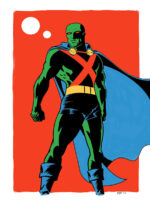Martian Manhunter: American Secrets illustrates how superhero comics can be used for retrospective moral satire.
The Martian Manhunter’s original Detective Comics adventures in 1959, written for children, contained no deliberate social satire. However, However, superhero characters’ longevity can make them handy vehicles for delivering the verdict of history on eras whose flaws weren’t so apparent at the time.
And J’onn J’onzz, a lonely alien exiled on Earth, turns out to offer a particularly useful outsider viewpoint for commentary on what fools these 1950s American mortals are.
This 1992 story, written by Gerard Jones and drawn by Eduardo Barreto, turns on crooked TV game shows, prefabricated cookie-cutter suburbs, the dangers of rock n’ roll, and lizard people disguised as ordinary Americans — the sort of paranoid science fictional fantasy that gave such a strong cultural charge to Don Siegel’s 1956 film Invasion of the Body Snatchers and Howard Hawks’ 1951 film The Thing from Another World.

When Denver police detective John Jones checks into a New York “businessman’s hotel” for a 1959 forensics convention, the bellboy smirkingly asks if he’d like “some companionship.”
The disguised Martian wants only a glass of milk, and switches on the TV, flipping through channels that are airing a Leave It to Beaver-type sitcom, a soap opera, a talk show attacking rock n’ roll, and The Big Question, a hit game show sponsored by “Refresh, the cigarette that restores your energy.”
“This is what the cold brings,” J’onzz thinks. “Companions on order. Companions that come alive with the snap of a knob. … Contests so they can cheer for the meaningless victories of strangers. Manufactured families. Staged communication.”
Watching a cop show, Jones recalls that television gave him his secret identity. “This is why I became a cop,” he thinks. “Stranded in this world, I wanted to be among its heroes. These were the heroes the culture showed me.”
The earlier superheroes — the new kinds of characters that had flooded the country during the 1930s and 1940s — are ironically referenced.
“There were other heroes before, I’ve heard, during Earth’s last great war,” the Martian Manhunter thinks. “But like all war heroes, they’ve faded.”
A little later, examining a copy of a Mad-type magazine for clues, Jones is informed that the newsstand isn’t a “library.”
 “I’ll buy it, just keep that cigar away from me,” the fire-phobic Martian says. Indicating a row of magazines featuring bare-breasted women with titles like Rascal Monthly and Oh Mister, Jones says, “Who buys all these magazines? What are they looking for? Like these. Who buys these?”
“I’ll buy it, just keep that cigar away from me,” the fire-phobic Martian says. Indicating a row of magazines featuring bare-breasted women with titles like Rascal Monthly and Oh Mister, Jones says, “Who buys all these magazines? What are they looking for? Like these. Who buys these?”
“Guys,” the newsagent says. “Normal guys. Now buy what you want and get moving.
After being ambushed by shape-shifting lizard men who discover his vulnerability to fire, John Jones is soon on the road in a big-finned pink Cadillac named Sheila with a girl who’s a quiz show darling and Elvis Presley (here called “Perkins Preston”).
In a development reminiscent of the 1967 James Coburn comedy-satire The President’s Analyst, the trio hides out in the determinedly placid, subtly sinister suburbs.
“People of all types, all backgrounds, and all creeds are welcome in Leavitzville,” a proud resident of suburbia tells them. “As long as they fit in.”
Meanwhile, in another room, we find out who doesn’t fit in. A boy showing off his Movieland Monsters magazine to Elvis learns that he grew up with black people around.
“Colored people?” the boy asks. “You’ve seen colored people? What are they like?”
 The story isn’t entirely successful, as Jeffrey Blair Latta observes on his Pulp and Dagger website.
The story isn’t entirely successful, as Jeffrey Blair Latta observes on his Pulp and Dagger website.
“Still, American Secrets is briskly paced, zigging and zagging as it goes,” Latta notes. “At first glance, J’onzz might seem an odd fit for the story, as conspiracy tales work best involving a relatively ‘average’ hero — not a guy who can throw the opposition around and fly. But Jones (the author) does generate a certain sense of helplessness, of J’onzz (the character) being up against a conspiracy of such scope, even with his powers he might not be able to fight it (a scene with J’onzz in his room while somebody pounds on the door is particularly effective). And by setting the story in the 1950s — between the superhero eras DC’s modern mythos now identifies — this is a Martian Manhunter largely on his own, with no other heroes he can turn to for assistance.”
Also, the juxtaposition of idealistic, heroic characters created for children with the cynical corruption of jaded adults can make the satire particularly pointed, showing us honesty and hypocrisy in stark contrast.

